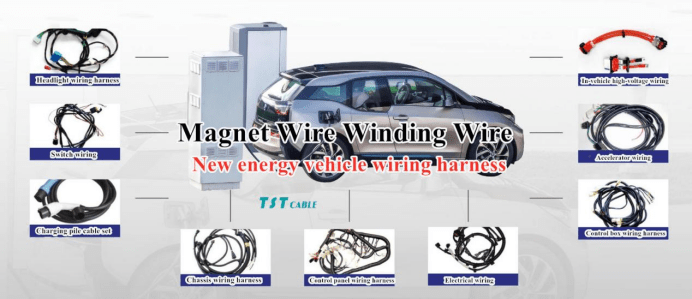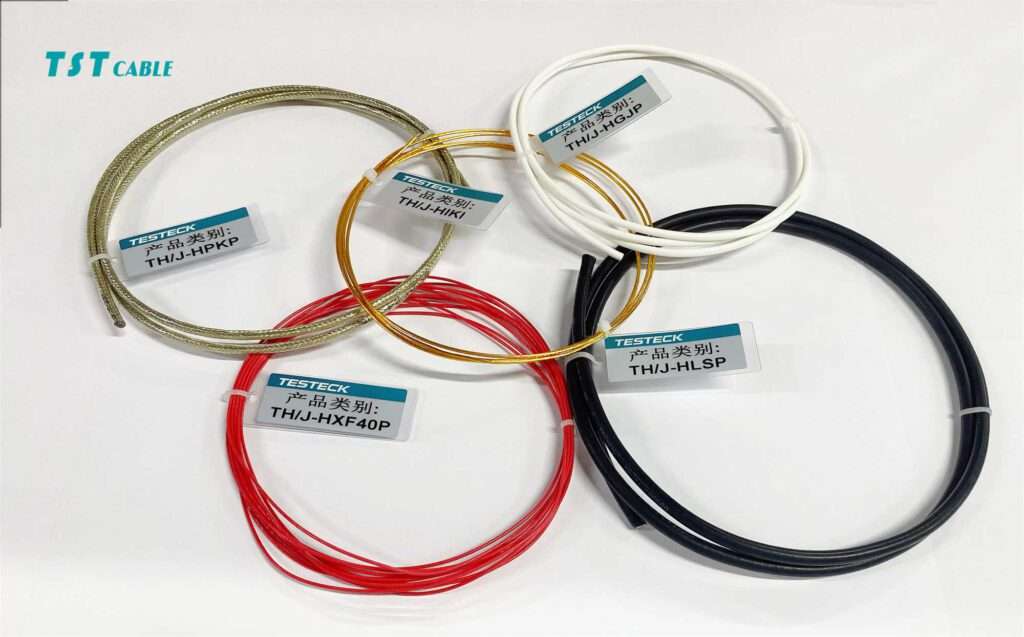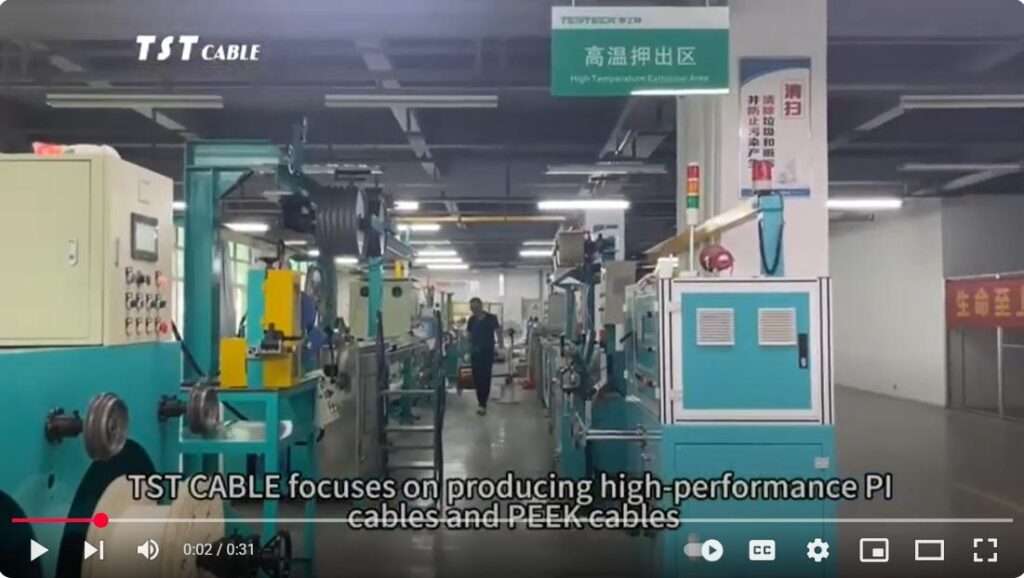
High-voltage silicone cables play a critical role in new energy electric vehicles (EVs). Their performance advantages and application scenarios are directly related to vehicle safety, energy efficiency, and reliability. The following describes the core applications and technical features of TST CABLE high-voltage silicone cables in new energy vehicles:

I. Core Application Scenarios for High-Voltage Silicone Cables for EVs
1. High-Voltage Power Transmission Systems
Battery Pack and Motor Connections: High-voltage silicone cables are used for series connection between battery modules and for high-current transmission between the battery and motor (e.g., the Tesla Model Y’s internal wiring is over 100 meters long).
Charging Systems: Connect charging ports to batteries, supporting fast charging (such as DC fast charging), and must withstand high voltages (3kV-40kV) and high transient currents.
Electronic Control Systems: Connect to the Battery Management System (BMS), Motor Controller (MCU), and other components to ensure efficient signal and energy transmission.
2. High-Voltage Equipment Connections
Air Conditioning Systems: Power supply cables for high-voltage equipment such as electric compressors and PTC heaters. DC/DC converters and inverters: Convert high-voltage direct current (HVDC) to low-voltage direct current (LVDC) and must withstand high temperatures and electromagnetic interference.
Onboard chargers (OBCs): Connect the AC charging port to the battery and must meet high-frequency switching and voltage resistance requirements.
3. Adaptability to special environments
Harsh operating conditions: Withstands salt spray, oil, and chemical corrosion (such as in the engine compartment).
Extreme temperatures: Maintains stable performance within the -60°C to +200°C range (such as when operating in extremely cold or hot regions).
II. Performance Advantages of High-Voltage Silicone Cables for EVs
1. High and Low Temperature Resistance and Chemical Stability
Temperature range: -60°C to +200°C (some new materials can reach +250°C), far exceeding the -40°C to +125°C limits of traditional PVC/XLPE cables.
Chemical resistance: Resists acids, alkalis, oils, and ozone, making it suitable for the complex operating conditions of new energy vehicles.
2. High flexibility and lightweight
Flexible design: multi-strand stranded tinned copper conductor (such as 22 0.34mm²) + silicone rubber sheath, small bending radius (120°), suitable for wiring in narrow spaces.
Weight reduction optimization: New silicone (such as Shin-Etsu KE-5641-U) achieves thinner sheath by improving dielectric strength (40kV/mm), reducing the weight of the entire vehicle cable by 10%-15%.
3. Electrical and safety features
High voltage resistance: UL3239 certified (40kV rated voltage), breakdown voltage reaches 50kV/mm (as described in [9]).
Low smoke and halogen-free: no halogen gas is released during combustion, in compliance with EN 50305 and EN 45545 railway fire protection standards.
Flame retardant: passed UL VW-1 vertical burning test (such as [9]), reducing fire risks.
4. Environmental protection and long life Non-toxic and harmless: Complies with RoHS 2.0 and REACH regulations, and does not contain harmful substances such as lead and cadmium. Aging resistance: After 1000 hours of aging at 200℃, the insulation resistance is still >1000MΩ·km (as described in [4]), and the service life is more than 5000 hours. III. Key standards and certifications for high-voltage silicone cables for EV new energy vehicles 1. International standards UL758/UL3239: American safety standards, which specify the pressure resistance, flame retardancy and mechanical properties of high-voltage silicone cables (such as [9], [10]). ISO 6722-1/-2: International Organization for Standardization electrical and mechanical requirements for electric vehicle cables. LV216: German Association of the Automotive Industry standard, which targets vibration and temperature cycle tests for electric vehicle cables. 2. Domestic standards QC/T 1037: Chinese industry standard, which specifies the materials, structures and test methods of high-voltage cables for new energy vehicles. DB44/T 2100-2018: Guangdong Provincial local standard, with requirements exceeding industry standards.
3. Environmental Certification
SGS RoHS testing: Ensures the absence of hazardous substances such as lead, cadmium, and mercury.
EU REACH Regulation: Restricts the use of 161 hazardous chemicals.
IV. Typical Products and Suppliers of EV High-Voltage Silicone Cables
1. UL3239 High-Voltage Silicone Cable (TST CABLE)
Parameters: Rated voltage 3kV~40kV, temperature range -40°C~200°C, passed the UL VW-1 flame test.
Applications: Microwave ovens, aviation equipment, new energy vehicle charging systems.
2. TST CABLE New Energy EV and EVP High-Voltage Cable
Technology: Patented high-voltage cable design (19 invention patents), compliant with ISO/IATF standards. Customers include BYD, Yutong, and others.
Features: Aluminum alloy conductor (lightweight), tinned copper conductor (high conductivity).
V. Future Trends 1. Material Innovation Graphene-enhanced silicone: Improve thermal conductivity and reduce core temperature (such as the heat dissipation design in [4]). Self-healing materials: Automatically repair microcracks and extend service life. 2. Lightweight and integration Thinner sheath: Reduce cable volume through high dielectric strength materials (such as Shin-Etsu KE-5641-U). Modular wiring harness: Reduce the number of connectors and improve assembly efficiency. 3. Intelligence Embedded sensors: Real-time monitoring of cable temperature and current to prevent overload and short circuit. Digital twin: Optimize wiring paths and material selection through virtual simulation. High-voltage silicone wire is the “neural network” connecting power, charging and control systems in new energy vehicles. Its extreme environment resistance, high flexibility and environmental friendliness make it the industry’s first choice. With the advancement of material technology and processes, high-voltage silicone wire will further develop in the direction of lightweight, intelligent and high reliability in the future. TST CABLE helps new energy vehicles achieve more efficient and safer operation.
Also available in:
English




